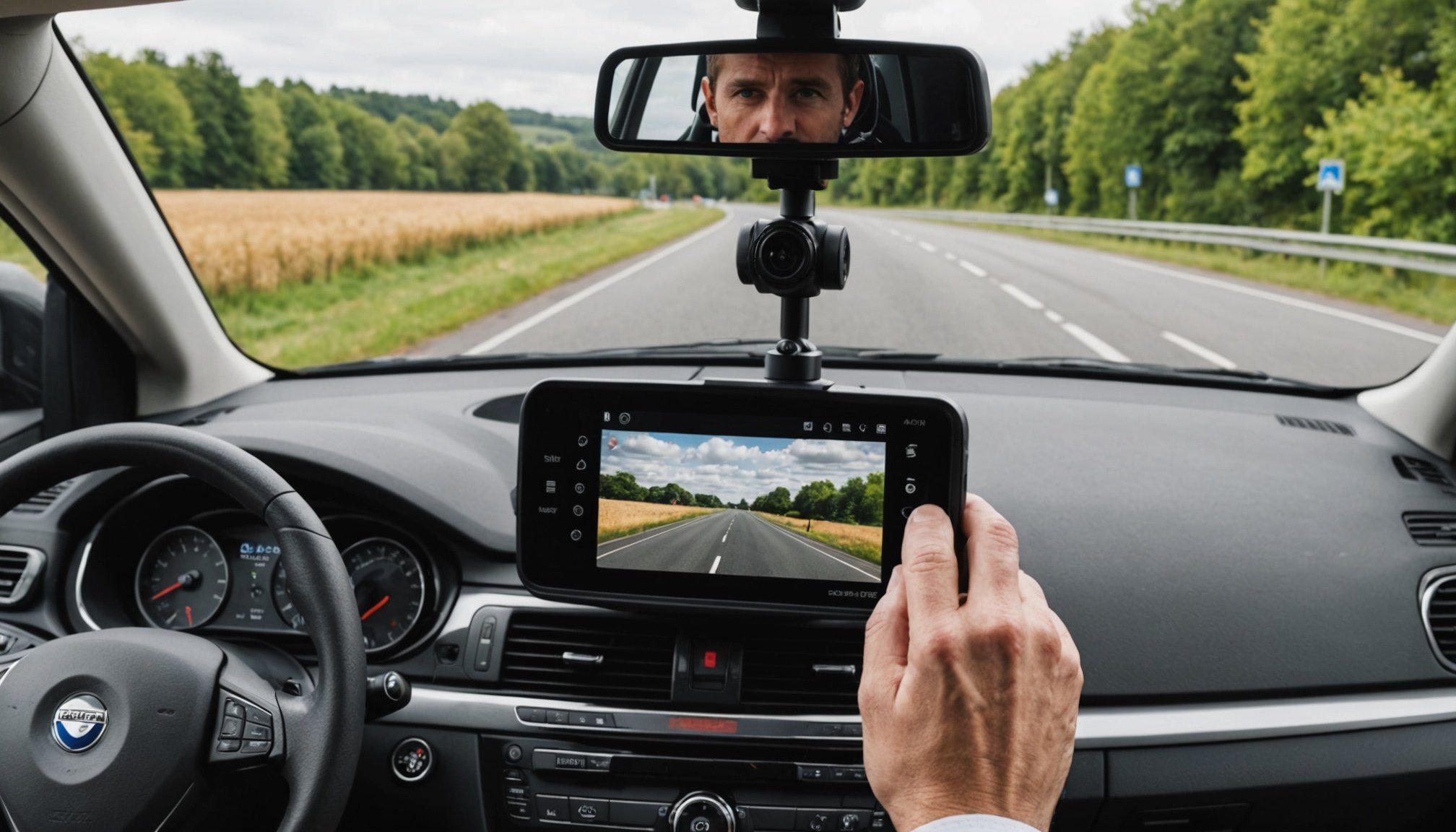Understanding the Importance of Dashcams
Dashcams have emerged as integral tools in modern vehicles, offering a wide range of vehicle security benefits. Primarily, dashcams record video footage while driving, providing crucial documentation in incidents. This documentation can include events like traffic accidents, road rage incidents, or parking mishaps. The recorded footage becomes invaluable during disputes, potentially absolving drivers from blame or identifying at-fault parties.
The impact on insurance claims and premiums in the UK cannot be overstated. Insurance companies increasingly consider dashcam footage when assessing claims, allowing for quicker and more accurate resolution. In some cases, providing dashcam evidence can directly lead to reduced premiums, offering a financial advantage to drivers.
This might interest you : Ultimate guide to installing a 360-degree dashcam in your british vehicle: expert tips for success
Dashcams generally come equipped with features such as loop recording, GPS tracking, and even speed monitoring, enhancing their practicality. These functionalities support a secure driving environment by continuously capturing detailed information about your vehicle’s journey. In addition, many dashcams now come with parking mode, providing surveillance even when the vehicle is stationary. This ensures that any incidents occurring while the car is parked are also documented, enhancing security further.
Overall, the integration of a dashcam into your vehicle can offer substantial UK insurance advantages, promote safer driver habits, and deliver peace of mind knowing that your journey is being reliably documented.
Also read : Mastering your uk-made suv: essential strategies to enhance stability control for optimal performance
Choosing the Right Dashcam for Your British Car
Selecting the ideal dashcam for your vehicle hinges on several important factors. Key considerations include camera resolution, field of view, and additional functionalities such as GPS tracking and speed monitoring. High-resolution cameras offer clearer images, crucial for capturing essential details like licence plates. A wide field of view ensures more of the road is visible, providing comprehensive documentation.
Features to Consider in a Dashcam
When evaluating dashcams, it’s vital to assess the features they offer. GPS functionality is particularly beneficial; it records your driving route and speed, providing additional layers of evidence in incidents. Quality dashcams might also include night vision for recording in low-light conditions, and event detection that saves footage if a sudden impact occurs.
Popular Dashcam Models in the UK
The UK market offers several popular dashcam models tailored to differing needs and budgets, such as the Nextbase 522GW and the Garmin Dash Cam 55. These models provide solid performance and user-friendly operations, making them excellent choices for British drivers.
Recommendations for Different Vehicle Types
When choosing a compatible dashcam, consider your vehicle type. Larger vehicles, such as vans, may benefit from dual-camera systems, while compact cars can suffice with single-lens solutions. Various options cater to budget constraints, ensuring safety is accessible to all drivers.
Necessary Tools and Equipment for Installation
Installing a dashcam in your vehicle requires a few essential tools and accessories which ensure a smooth installation process. First, gather necessary tools like a screwdriver set, trim removal tools, and cable management supplies such as clips or dashcam-specific adhesives. These basic tools help you safely and securely attach the dashcam without damaging your vehicle’s interior.
For optimal installation, consider additional accessories such as hardwiring kits. These kits directly connect the dashcam to the vehicle’s fuse box, maintaining a tidy setup and enabling features like parking mode. Also, extra-long cables might be required, particularly for larger vehicles or dual-camera setups.
Preparing your vehicle for dashcam installation is critical to avoid obstructions in the view and ensure safety. Clean and clear the area where the dashcam will be mounted, usually near the windshield and behind the rearview mirror. Remove any decals or objects that could interfere with the camera’s field of view. Additionally, ensure that any electrical work is handled with care, considering professional help if necessary, to prevent damage to the vehicle’s wiring or systems.
Step-by-Step Guide to Installing a Dashcam
Navigating the dashcam installation guide can be simple and rewarding. Begin by gathering essential tools like a screwdriver set and trim removal tools. These ensure your installation process is smooth and does not damage your vehicle’s interior. Let’s delve into the specifics of installation:
Preparing for Installation
Before diving into the installation, prepare your workspace by clearing clutter to avoid obstructions. Ensure you have a clean, unobstructed area on your windshield to mount the dashcam, usually just behind the rearview mirror. This positioning offers the best field of view, ensuring comprehensive coverage of the road ahead.
Mounting the Dashcam
Carefully use the installation accessories such as adhesive pads or suction cups provided. Align the dashcam with your predetermined position, ensuring it’s level and securely attached. Adjust the device for optimal recording orientation.
Connecting Power and Testing
There are multiple methods for powering your device. Use a cigarette lighter adapter for simplicity, or opt for a hardwiring kit for a tidier finish. After connecting power, you must verify the functionality. Check video recording quality by reviewing footage, confirming features like GPS and speed monitoring are operational. Ensuring your dashcam is correctly installed sets the stage for enhanced vehicle security.
Legal Considerations and Regulations in the UK
When incorporating a dashcam into your vehicle, understanding dashcam laws in the UK is essential. These regulations mainly focus on the ethical use of footage and privacy concerns. Generally, dashcams are legal in the UK, but users must comply with laws ensuring footage is used responsibly.
Guidelines for Using Dashcam Footage as Evidence
Dashcam footage is widely accepted in UK courts, but adherence to guidelines is vital for it to be considered valid evidence. Ensure that recordings are date- and time-stamped. Furthermore, footage must be complete, showing the full sequence leading to an incident, as cherry-picking moments can weaken your case or promote bias.
Privacy Concerns and Data Protection Regulations
Vehicle surveillance regulations stress protecting other road users’ privacy. It’s crucial to refrain from sharing identifiable footage of others without consent. The General Data Protection Regulation (GDPR) mandates that dashcam owners are responsible for ensuring data protection and respecting privacy, especially concerning shared and stored media.
Dashcam laws in the UK encourage ethical usage, safeguarding both personal and public interests. Understanding these regulations fosters responsible recording, ultimately enhancing vehicle security benefits while aligning with legal standards. Following these legal considerations ensures that your dashcam usage remains above reproach, mitigating potential disputes.
Tips for Maintaining and Using Your Dashcam Effectively
Maintaining a dashcam is crucial for optimal performance and longevity. Routine checks are imperative, focusing on cleaning the lens regularly to ensure clear recordings unaffected by dust or smudges. Inspect cables and connectors periodically to prevent wear and tear, thus avoiding abrupt power disruptions.
Regular Maintenance Practices
- Keep the lens clean: Regularly clean the dashcam lens using a microfiber cloth to maintain clear footage.
- Check mount stability: Ensure the dashcam remains securely attached to avoid disruptions during recordings.
Managing Stored Footage
Efficient footage management enhances both device performance and usability. Regularly transfer files to external storage to free up space on the dashcam. Utilize organized labeling systems to simplify the retrieval of specific recordings. It’s advisable to adopt a backup routine for important files, safeguarding against potential data loss.
Ensuring Optimal Performance
To sustain optimal dashcam functionality, update the device firmware regularly. This practice fixes bugs and adds enhancements, keeping the device current. If you encounter performance issues, consider resetting the dashcam to factory settings as a troubleshooting measure. With these strategies, you can ensure your dashcam remains reliable and functional.
Additional Benefits of Dashcams Beyond Security
Beyond traditional vehicle security benefits, dashcams play a significant role in promoting driving safety and protecting against fraudulent claims. By continuously monitoring and recording your driving behaviour, dashcams encourage safer habits. Knowing that every move is documented can profoundly impact drivers’ attentiveness and responsibility on the road.
Crucially, dashcams serve as a deterrent against fraudulent claims, a concern increasingly prevalent in the UK. With clear footage, drivers can defend themselves against false accusations, providing undisputable evidence in insurance disputes. This UK insurance advantage extends beyond reducing premiums, safeguarding against financial loss from unwarranted claims.
Moreover, community advantages emerge as dashcams capture insights valuable for broader safety awareness. Sharing footage of road conditions, hazards, or exemplary driving moments fosters a culture of safety within communities. Dashcam clips can serve as educational tools, offering real-world examples to illustrate safe driving principles or highlight common road mistakes. This shared knowledge promotes collective safety, emphasising the impact of responsible driving behaviour.
Thus, dashcams transcend their primary function, contributing to individual security and fostering a more informed and vigilant road-sharing community. These multifaceted dashcam benefits underscore their essential place in modern vehicles.











